
A manor house was historically the main residence of the lord of the manor. The house formed the administrative centre of a manor in the European feudal system; within its great hall were usually held the lord's manorial courts, communal meals with manorial tenants and great banquets. The term is today loosely applied to various English country houses, mostly at the smaller end of the spectrum, sometimes dating from the Late Middle Ages, which currently or formerly house the landed gentry.

Dunboy Castle is a ruined 15th-century castle on the Beara Peninsula in south-west Ireland near the town of Castletownbere. The castle's tower house and bawn were destroyed in the 1602 Siege of Dunboy, though its ruins remain open to the public.

Portumna is a market town in the south-east of County Galway, Ireland, on the border with and linked by a bridge to County Tipperary. The town is located to the west of the point where the River Shannon enters Lough Derg. This historic crossing point over the River Shannon between counties Tipperary and Galway has a long history of bridges and ferry crossings. On the south-western edge of the town lie Portumna Castle and Portumna forest park.
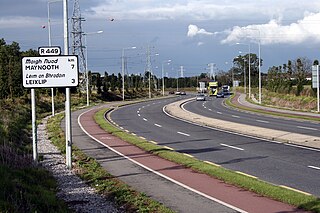
A regional road in the Republic of Ireland is a class of road not forming a major route, but nevertheless forming a link in the national route network. There are over 11,600 kilometres of regional roads. Regional roads are numbered with three-digit route numbers, prefixed by "R". The equivalent road category in Northern Ireland are B roads.

Cloughjordan, officially Cloghjordan, is a town in County Tipperary in Ireland. It is in the barony of Ormond Lower, and it is also a parish in the Roman Catholic Diocese of Killaloe.

Oliver Canning is an Irish retired hurler who played as a left corner-back for the Galway senior team.

Durrus is a village and civil parish in West Cork in Ireland. It is situated ten kilometres (6 mi) from Bantry in County Cork, at the head of the Sheep's Head and the Mizen Head peninsulas.
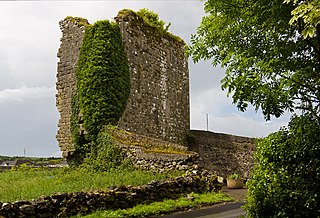
Castlegar is a village and electoral division in County Galway, just outside the city of Galway, in Ireland. Castlegar is also an ecclesiastical parish in the Roman Catholic Diocese of Galway, Kilmacduagh and Kilfenora. It extends from Lough Corrib across to Merlin Park by the old Galway-Dublin road.
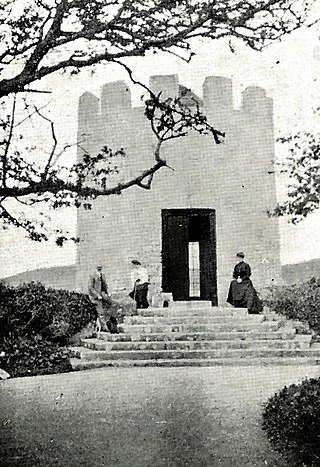
Rostellan is a civil parish, townland and village in the historical Barony of Imokilly, County Cork, Ireland. An electoral division of the same name forms part of the Cork East Dáil constituency. For census purposes, the village of Rostellan is combined with the neighbouring villages of Farsid and Aghada. As of the 2011 census, the combined settlement of Aghada-Farsid-Rostellan had a population of 1,015 people.

Portnablagh is a small village in County Donegal in Ulster, the northern province in Ireland. Portnablagh is located on the north-west coast of County Donegal, specifically the west side of Sheephaven Bay. It is on the N56 road.
Lorrha is a small village at the northern tip of County Tipperary, Ireland. Ledewich described village as 'Larah' which is the common name for the talk-motes, mote hills etc. P. Dixon Hardy M.R.I.A. describes it as 'Loragh'

Mount Loftus is a country estate in the civil parish of Powerstown in County Kilkenny, Ireland. It was originally home to the Loftus baronets, the baronetcy being extinct since the death of the third baronet in 1864. The original 18th century manor house was demolished in 1906. The current house on the estate, built in the early 20th century, was rebuilt from staff accommodations after a fire in the 1930s. This house, and several of its outbuildings, are included on Kilkenny County Council's Record of Protected Structures.

Dunlough Castle, standing atop the cliffs at the northern tip of the Mizen Peninsula, looks at the Atlantic Ocean from the extreme southwest point of Ireland. Founded in 1207 by Donagh O’Mahony, Dunlough is one of the oldest castles in Ireland and an example of Norman architecture and dry stone masonry.

Dinny Cahill is an Irish hurling manager and former player. He is the former manager of the Antrim senior hurling team.

Moorstown Castle is a late 15th-century stone structure consisting of an enclosed circular keep near Clonmel, County Tipperary, Ireland.
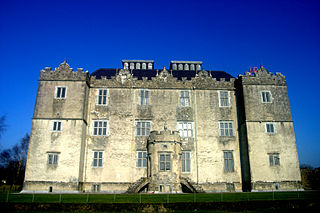
Portumna Castle is a semi-fortified house in Portumna, County Galway, Ireland which was built in the early 17th century by Richard Burke, 4th Earl of Clanricarde.

Menlo Castle or Menlough Castle, also called Blake's Castle, is a 16th century castle situated on the bank of the River Corrib near Menlo village in County Galway, Ireland.
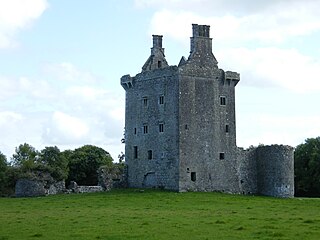
Derryhiveny Castle is a tower house and National Monument located in County Galway, Ireland.

Castlehyde is a townland and estate, slightly west of Fermoy in County Cork, Ireland. The estate's manor house, Castlehyde House, had been the ancestral home of Douglas Hyde's family and is one of several houses owned by Irish dancer, Michael Flatley.



















